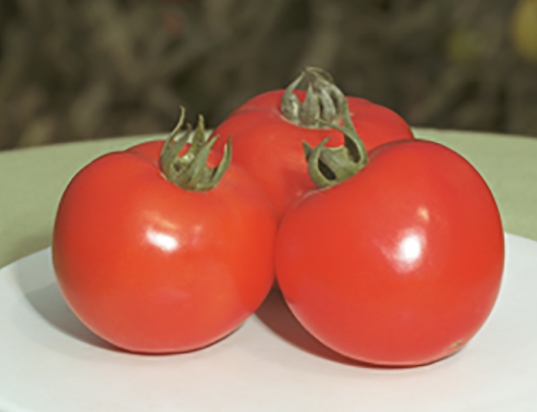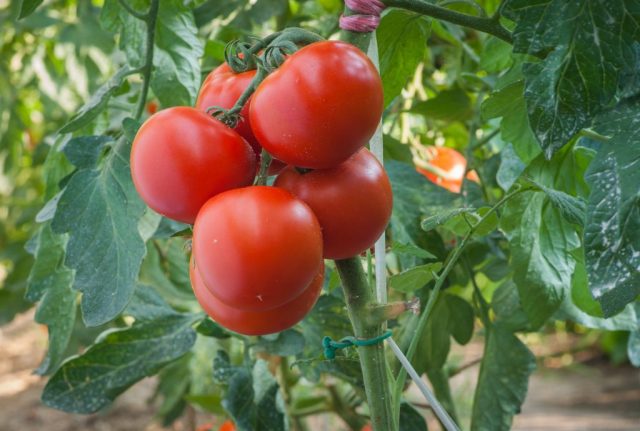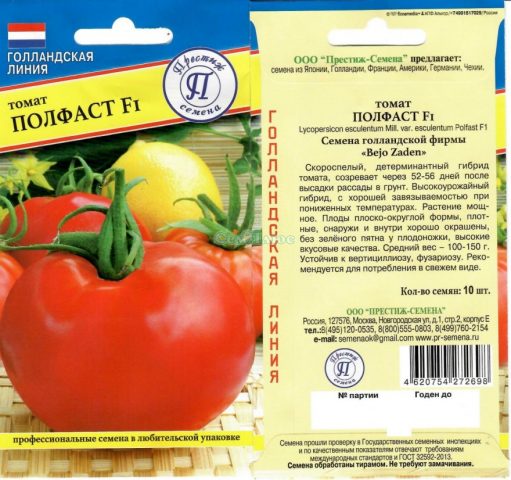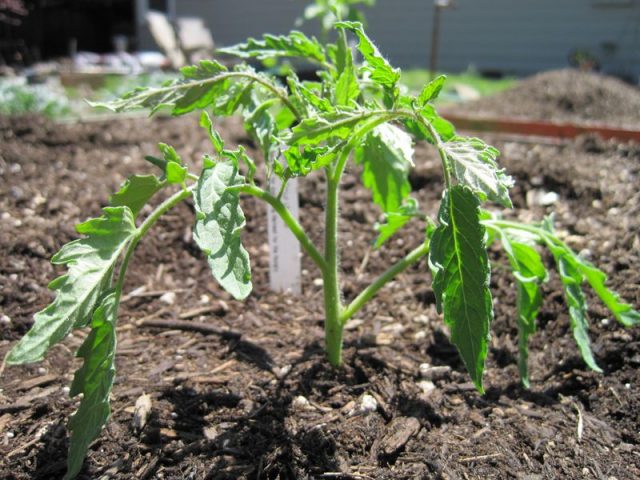Content
Tomato Polfast f1 is the development of the famous Dutch company Bejo Zaden. The tomato hybrid has been included in the State Register of Russia since 2005. The harvest tomato is resistant to a number of diseases and unstable weather in the middle climatic zone, therefore it is attractive for large farms and summer residents.
Description of tomato halffast
In a plant of a determinant variety, the bushes are low, sometimes they rise with abundant watering up to 65-70 cm, but on average 45-60 cm. Compact tomato bush Polfast f1 medium leafy, moderately branched. The dark green leaves are large to medium. Simple inflorescences bloom on fruit clusters, from 4 to 6 ovaries are formed. For high yields, gardeners take care of a good level of soil nutrition where the hybrid is growing.
The variety is grown in vegetable gardens without shelter and in greenhouses. Tomatoes of the Polfast variety are marked in the State Register as medium early, the harvest is harvested 86-105 days after the first shoots. Ripening times vary depending on temperature conditions if tomatoes are planted in open ground. Based on the reviews and photos of tomato bushes Polfast f1 with a good harvest, we can conclude that the plant is suitable for cultivation in the gardens of the middle climatic zone. When growing a hybrid tomato variety, standard agricultural techniques are used.
Now the seeds of the hybrid are distributed by the companies "Gavrish", "Elkom-seeds", "Prestige". The variety has a good yield - up to 6.2 kg per 1 sq. m, if all the requirements of agricultural technology are met. Since it is advised to place the Halffast hybrid in the amount of 7-8 plants per 1 sq. m, it turns out that one tomato bush gives 700-800 g of tasty vitamin products. The fruits from the greenhouse can be enjoyed from the end of June; in the open field in the middle lane, tomatoes will ripen in July, early August.
Hybrids are more productive than regular tomato varieties, but for a good harvest of vegetables it is worth taking care:
- on the enrichment of the site with organic matter and mineral fertilizers;
- about carrying out regular watering;
- about supporting tomatoes with top dressing.
According to the description, tomato Polfast f1 is resistant to pathogens of fungal diseases such as verticillium and fusarium. Due to the early ripening, the plants of the Dutch variety have time to give the harvest before the time of the usual spread of late blight. At the first signs of late blight disease, it is recommended to collect the fruits of even green tomatoes, which are well ripened. Housewives also use unripe tomatoes for various preparations for the winter. Diseased bushes are removed from the garden and burned or thrown away at a centralized waste collection site.
Brief description and taste of fruits
Flat-round tomatoes of the Polfast variety of medium size, at the base, near the stalk, ribbed. The mass of ripe tomatoes is from 100 to 140 g. Some gardeners claim that on their plots the fruits of the Polfast variety reach 150-180 g in the open field. The peel of the tomatoes is dense, thin, does not crack, and is not felt when eaten. The fruits of tomatoes Polfast f1, according to reviews and photos, fell in love with gardeners with a neat shape, bright red peel and fleshy, juicy pulp.
There are almost no seeds in the fruits of the salad variety, the pulp is dense, sweetish, with a high dry matter content, pleasant with the presence of a small sourness characteristic of tomatoes.
The density of the skin and pulp of hybrid tomatoes allows you to transport vegetables without compromising their appearance and taste. The fruits of the variety are consumed fresh, used for canning, making juices, pastes and sauces. Farms send batches of Polfast tomatoes to processing plants as an excellent raw material for canned food.
Pros and cons of the variety
Polfast tomatoes have the same benefits as most hybrids:
- high productivity;
- compactness of the bush shape;
- good commercial properties;
- balanced taste;
- versatility in cultivation and use;
- unpretentiousness to natural conditions;
- resistance to a number of fungal diseases.
The variety has no pronounced shortcomings. Gardeners have long appreciated the advantages of new generations of hybrid plants. There are only comic complaints that the seeds of the hybrid tomato variety Polfast cannot be collected on their own.
Planting and care rules
It is not difficult to plant, grow and get tasty vitamin products of an unpretentious tomato, and novice farmers can do it.
Sowing seeds for seedlings
For seedlings in open ground, seeds of tomatoes of the Polfast variety are sown from mid-March. You can start growing seedlings for greenhouses at the end of February, beginning of March. For strong seedlings of Polfast tomatoes, a nutritious substrate is prepared:
- equal parts of garden land and well-rotted humus;
- some clean sand for lightness and looseness of the soil;
- 0.5 l of wood ash in a bucket of the specified mixture.
First, the seeds are sown in one large container, then they are dived into separate cups, which must be taken care of in advance. All seeds of the hybrid variety Polfast from reputable producers are processed. Gardeners do not carry out pre-sowing preparation.
Algorithm for the initial stage of seedlings:
- the grains are deepened into the substrate by 1-1.5 cm, slightly moistened the soil, covered with a film and placed in a warm place with a temperature above + 20 ° C;
- seedlings appear in 6-8 days;
- so that weak stems do not stretch out, the temperature is reduced for 5-6 days to + 18 ° C, and the container is kept under special lighting devices if there is not enough natural sunlight;
- during this time, shoots of all seeds appear, and the main part of the shoots is gaining strength, the stems become stocky, the cotyledon leaves are straightened;
- Seedlings of the Polfast variety are again provided with warmth up to + 25 ° C and continue to light up;
- when 2-3 true leaves grow, the seedlings dive - they tear off 1-1.5 cm of a long taproot and transplant into a glass one by one;
- after 7-10 days, tomato seedlings are fed with fertilizers for seedlings, and then the support is repeated after 2 weeks, at the beginning of the hardening process.
Transplanting seedlings
In early May, Polfast tomatoes are planted in an unheated greenhouse, they are moved to the garden without shelter, guided by the weather forecast, in late May or early June. The wells are divided according to the 40x50 cm scheme. When planting, a tablespoon of ammonium nitrate is placed in each. Before transplanting, pots with tomato seedlings Polfast are watered abundantly so that when handling the earthen lump it is easy to remove it without damaging the roots. It is advisable to hold the purchased material according to the instructions in solutions of "Fitosporin" or "Immunocytofit" to stimulate the growth of tomatoes and increase resistance to diseases.
Tomato care
The first watering of seedlings after moving is carried out, guided by the state of the soil and the air temperature, for 2-3 or 5-6 days. Then the tomatoes are watered regularly 1-2 times a week, the soil is loosened, chopped off weeds, on which insect pests and pathogens can breed.In case of drought, it is better to mulch the tree trunks with dry grass without seeds in order to retain moisture longer.
Hybrid varieties reveal their potential with sufficient nutrition, therefore, Polfast tomatoes are fed with various potash and phosphorus fertilizers, better complex ones, with microelements, where the composition is ideally balanced:
- potassium monophosphate;
- "Kemira";
- "Kristalon";
- "Signor Tomato" and others.
Tomatoes of the variety respond well to foliar feeding with the drug "Mag-Bor" or a mixture of boric acid and potassium permanganate. Tomatoes are grown once a week; the bushes of the compact variety do not need a garter.
If necessary, fungicides are used against diseases:
- Thanos;
- "Previkur";
- Trichodermin;
- "Quadris".
Pests are driven away with folk remedies or insecticides.
Conclusion
Tomato Polfast f1 is a wonderful variety for the climate of the middle zone, resistant to the vagaries of the weather, little susceptible to dangerous fungal diseases. The determinant variety does not require special formation, but is responsive to feeding and systematic watering. Attractive with a stable harvest.












